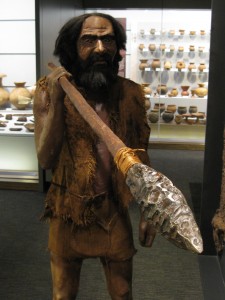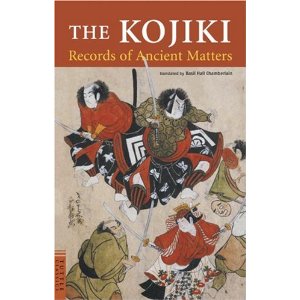The origin of Shinto is a hot topic, because it determines how one views the religion. Is it a uniquely Japanese affair which has continued since ancient times, or is it an invented tradition which has been constructed to serve the ends of the ruling class?
When did Shinto begin? Here are seven possible answers. Take your pick…

Jomon man (Kokugakuin University Museum)
1) Jomon Period. (c.10,000 BC – 300 BC)
Some commentators see links between the spirituality of ancient Jomon people and Shinto animism. Clay figurines of pregnant women may have been used in fertility rites. An archaeologist at my university, who specialises in Jomon religion, believes there was a form of ancestor worship (based on their family burials).
This viewpoint is particular popular with traditionalists, who see Shinto as an indigenous faith which has existed in Japan since time immemorial. ‘Shinto is the traditional faith of Japan, with a history extending from remote antiquity to the present,’ writes Umeda Yoshimi, director general of the International Shinto Foundation. State Shinto maintained mythical Emperor Jinmu founded Japan in this age in 660 B.C.
2) Yayoi Period. (c.300 BC – 250 AD)
This may be the standard view, since it’s said that Shinto is based around wet-rice cultivation which was introduced to Japan in this age. Rice, rice-rope and rice wine remain essential components of ceremonies, and many of the most important rites and festivals celebrate the planting or harvesting of rice. The notion of kami moving down from the mountains in spring to return in autumn is also associated with this period.
The influx of influences from the continent, together with differences in body type, has led to debate about the extent to which the newcomers affected native ways and the genetic stock.
3) Fourth or fifth century.
Archaeological evidence at sites like Omiwa, Izumo and Okinoshima suggest that offerings and rituals date back to around this time. It was most likely a time of clan kami, rock worship and temporary shrines in clearings. The shamenness Himiko lived in the mid-third century, and not long afterwards the Omiwa court flourished with worship at its sacred mountain. It was the nucleus of the emerging Yamato kingdom, whose religious practice was to shape what is now known as Shinto.
4) Sixth century
The arrival of Buddhism in 537 brought awareness for the first time of a native tradition. Up to this time there had been a range of diverse practices, including shamanism, fertility rites, kami worship, nature deities, exorcism etc. There was no sense of commonality. However, the arrival of foreign deities threatened traditional practices and native deities, which were championed by the Mononobe and Nakatomi clans. The powerful Soga clan on the other hand proclaimed Buddhism, and the two sides clashed at the battle of Shigisen in 587. The victory of the Soga led in 604 to Prince Shotoku’s 17 Article Constitution, which cemented the country as Buddhist though the emphasis on harmony made it plain that kami too should be respected.

Kojiki's publication in 712 wove a coherent narrative of divine origins out of divergent myths
5) With the Kojiki (712) and Nihon shoki (720).
The first recorded use of the word ‘Shinto’ comes in the Nihon shoki, where it is used to differentiate the native traditions from Buddhism. It followed a coup in 672 by Emperor Tenmu, who usurped his nephew and then sought to legitimise his power by investing the ruler with spiritual authority. Mythologisers were ordered to compile histories which would show the emperor’s divine lineage, together with that of the clan leaders who supported him. It led too to an official hierarchy of shrines organised under imperial patronage. It was around this time that comes the first usage of the title ‘tenno’ (emperor). The centralisation suggests the beginning of an organised religion, though it’s argued that this only affected the small court circle and did not affect the population at large.
6) Medieval times.
In recent years the notion has been gaining ground that a self-conscious ideology called Shinto only emerged in medieval times. The view has been championed by John Breen and Mark Teeuwen in their book A New History of Shinto, in which Yoshida Kanetomo (1435-1511) is credited with being the first to articulate a theory that could be in any meaningful sense be called Shinto. It was in this age too that other theoretical forms of Shinto emerged, such as Watarai Shinto. The argument here is that previous to this there was no consciousness of identifying with something called Shinto.
7) Meiji times.
The scholar Kuroda Toshio argued forcefully that Shinto as we know it today was a Meiji-era invention, and that previous to that no independent religion but rather a Japanese form of Taoism (in ancient times) and a form of esoteric Buddhism (after the Heian age). Such was the case during the Edo period, when most kami worship was carried out by Buddhist priests. With the Imperial Restoration of 1868 politicians decided the country needed a state religion in the manner of Western countries, which were bolstered ideologically by Christianity. The government decided therefore to separate Shinto from Buddhism, despite more than a thousand years of integration. Shrine-temple complexes were divided, Buddhist items removed from shrines, and priests forced to choose to be either Shinto or Buddhist. Syncretic practices like shugendo (mountain asceticism) were banned altogether. The emperor was championed as supreme spiritual authority, and the imperial link with Ise was cemented by Emperor Meiji making the first visit since the time of Empress Jito in 692.

Leave a Reply